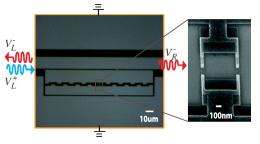August 22, 2011 feature
Physicists build first single-photon router

(PhysOrg.com) -- By demonstrating that an artificial atom embedded in a transmission line can route a single photon from an input port to one of two output ports, physicists have built the first router working at the single-photon level. The single-photon router could one day serve as a quantum node in a quantum information network, in which it could provide basic processing and routing of data.
The scientists, led by Per Delsing and Chris Wilson from the Chalmers University of Technology in Göteborg, Sweden, with coauthors from there and the Spanish National Research Council in Madrid, Spain, have published their study in a recent issue of Physical Review Letters.
As the scientists explain, controlling and directing photons is more difficult than controlling and directing electrons, which are used in most of today’s routers. The difficulty stems from the fact that, unlike electrons, photons do not strongly interact with each other. However, one of the important requirements of a quantum channel is the ability to distribute information over large distances. Since photons can coherently travel much further distances than other quantum systems such as atoms, it makes sense to use photons as the information carriers in quantum information networks.
To build their single-photon router, the scientists used a superconducting qubit as the “artificial atom” (although the qubit is actually made of several atoms, it has discrete energy states like a real atom). Then the scientists coupled the qubit to a one-dimensional transmission line through which microwave photons travel. Next they applied a weak, continuous photon probe and sometimes added a stronger control pulse. Without the strong control pulse, the artificial atom reflects the incoming photons, which travel to output 1. When the strong control pulse is on, it leads to the phenomenon of electromagnetically induced transparency (EIT). EIT causes the atom to become transparent to the weak probe beam, resulting in the photons traveling past the atom to output 2. In this way, the scientists could direct incoming photons to one of two output ports.
“Electromagnetically induced transparency based on a single atom has been demonstrated in the optical domain, but with rather low extinction efficiency,” Delsing told PhysOrg.com. “In the microwave domain, 90% has been obtained by a Japanese group, but it was not set up as a router. Thus you could say that this is the first router working at the single photon level. In addition it has high efficiency, 99%, and it is quite fast.”
The researchers achieved an order of magnitude increase in the extinction efficiency (reaching 99.6%), which shows that the photons are efficiently coupled to the artificial atom, enabling the photons to be better controlled. The device’s switching time (the time it takes to switch incoming photons from one output port to the other) is just a few nanoseconds.
The scientists also noted that the router can easily be extended to have multiple output ports, which will be necessary for use as a quantum node.
“We have several new experiments in mind, one is to implement the multiport router we describe in the paper,” Delsing said. “Other possible experiments include to have multiple artificial atoms in the same transmission line and to increase the number of ‘atoms’ and photons that interact. We are moving towards large scale integration of quantum objects.”
For applications in quantum channels, the scientists explain that it will be better to use optical photons instead of microwave photons, which were used here. The device could also have important applications in research.
“The router can be very useful in research where it can be used, for example, to distribute photons from a single-photon source to several experiments on the same chip,” Delsing said. “This will allow for much more compact and integrated experiments with microwave photons.
“Photons are ideal carriers of quantum information,” he added. “With this router we can distribute and route microwave photons carrying quantum information. In future quantum computers it may be very useful to communicate within and between different quantum computers. In the far future one can imagine what is sometimes referred to as the quantum internet. However, then one would also need additional devices such as a quantum interface between optical and microwave photons and so-called quantum repeaters.”
More information: Io-Chun Hoi, et al. “Demonstration of a Single-Photon Router in the Microwave Regime.” Physical Review Letters 107, 073601 (2011) DOI:10.1103/PhysRevLett.107.073601
Copyright 2011 PhysOrg.com.
All rights reserved. This material may not be published, broadcast, rewritten or redistributed in whole or part without the express written permission of PhysOrg.com.




















